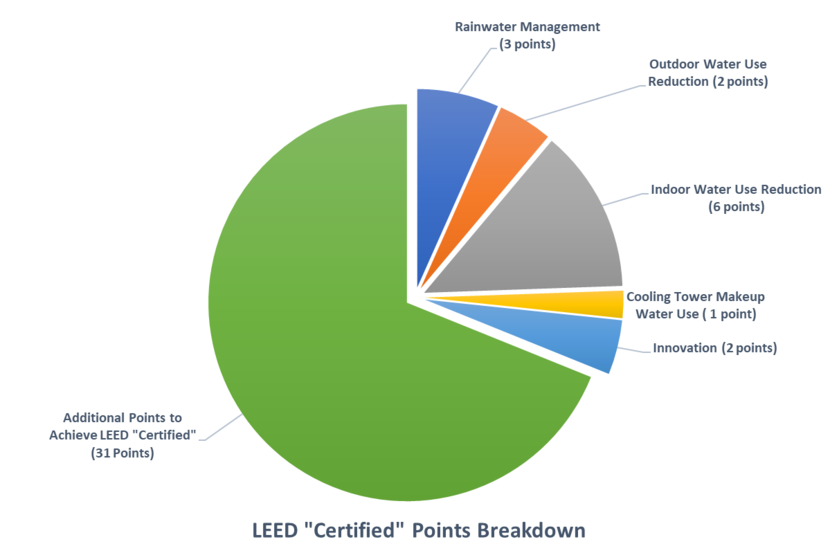What is LEED?
March 6, 2019

Leadership in Energy and Environmental Design® (LEED) is a world-wide recognized international mark of excellence for green building and is a symbol of sustainability achievements. Developed by the non-profit U.S. Green Building Council (USGBC), LEED has been designed to encourage building owners and operators to adopt sustainable strategies and designs in critical areas of human and environmental health.
There are a number of LEED® rating systems available to meet the needs of different building and project types. Each LEED rating system is comprised of a variety of prerequisites and credits. Prerequisites are required elements or strategies that must be included in any LEED certified project. Credits are optional elements or strategies that projects can elect to pursue to gain points toward LEED certification.
Buildings are awarded points based on the extent that various sustainable strategies are achieved. The more points awarded the higher the level of certification achieved from Certified, Silver, Gold, to Platinum.
- Certified: 40-49 points earned.
- Silver: 50-59 points earned.
- Gold: 60-79 points earned.
- Platinum: 80+ points earned.
Projects seeking LEED certification earn credits across nine categories addressing sustainability issues, such as sustainable sites and water efficiency.
If you are interested in LEED certification for your green building project, Net Zero Water rainwater harvesting systems can help you to earn up to 14 points for LEED v4. Here’s how…
The Green Building Council gives LEED points for obtaining certifications to buildings that implement rainwater harvesting. A Rainwater harvesting and reuse strategy can earn a significant number of LEED points. About one-third of points required for LEED Certification, across several categories, can be achieved by using a single mechanical rainwater harvesting system.

What points can be achieved with our Rainwater Harvesting system
Sustainable Sites
- Rainwater Management (3 Points)
Rainwater harvesting system reduces peak discharge rate and quantity of stormwater runoff from a site by detaining the stormwater on site. this, as a result, helps to improve water quality and replicate natural site hydrology processes by managing the runoff and retaining sediments and other pollutants.
Water Efficiency
- Credit 1: Outdoor Water Use Reduction (2 points)
Rainwater harvesting provides an additional water supply option for landscape irrigation applications. You may earn 1 point for reduction of potable water consumption for irrigation by 50%, or 2 points for reduction of potable water consumption for irrigation by 100%.
- Credit 2: Indoor Water Use Reduction (6 points)
A rainwater harvesting system can provide an alternative water source for non-potable applications such as toilet and urinal flushing. You may earn 1 to 6 points by further reducing municipal water use from 25% to 50% and more.
- Credit 3: Cooling Tower Water Use (1 point)
Rainwater harvesting system can offer additional water supply for cooling tower makeup water use. 1 point can be earned by using a minimum 20% recycled non-potable water.
Innovation
- Credit 1: Exemplary performance (1-2 points)
A rainwater harvesting system can help improve the indoor water use reduction of a project beyond the threshold of 50% listed in WE Credit 2: Indoor Water Use Reduction.
How rainwater harvesting helps:
Rainwater harvesting provides the combined benefits of on-site stormwater management and water conservation for your new development.
Rainwater harvesting helps to reduce the quantity of stormwater runoff during rainfall events. A rainwater harvesting system will capture and store the runoff that would typically leave the site through a storm sewer. This water can be treated and used on site for applications that don’t require potable quality water such as landscape irrigation, toilet/urinal flushing or cooling tower makeup water. The use of harvested rainwater for irrigation and other non-potable applications will not only reduce potable water demand for a site, but also reduce the load on municipal water supply and wastewater facilities.
Rainwater harvesting also reduces the pollution from stormwater runoff by drastically reducing the quantity of runoff from a site. The runoff detained on site is usually routed through a filtration system to improve the harvested rainwater before use.
In addition to water conservation/runoff volume reduction benefits, rainwater harvesting systems can help to meet peak flow control requirements and attenuating peak discharge rates. Cisterns can provide temporary detention and gradual release of incoming runoff during the medium or large sized storm event.
Download the Guide to Budgeting for a Commercial Rainwater Harvesting System here.
